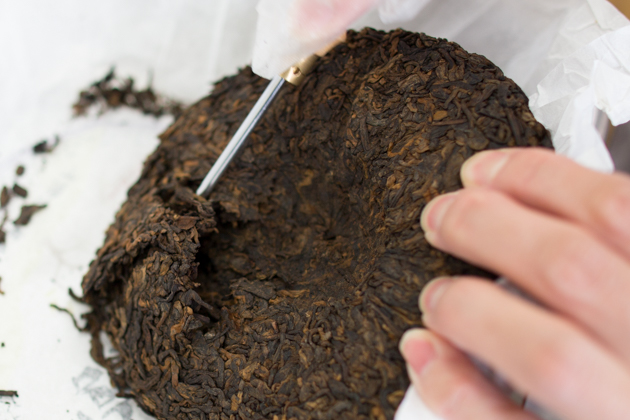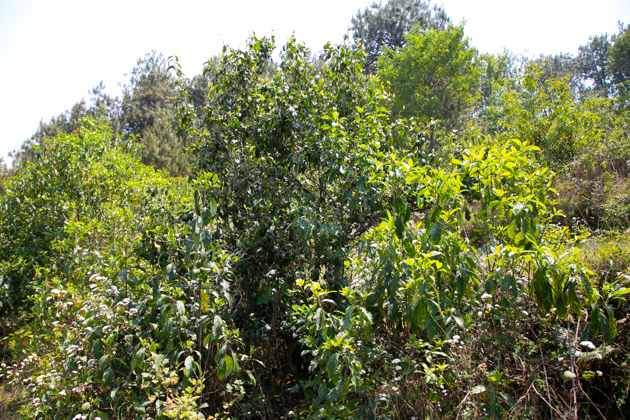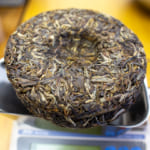- HOME >
- New Arrival at HOJO Online Shop
New Release of Gong Ting Jin Hao From Huo Cao Shan
- [2019.01.25] Posted By Akira Hojo

Now we got good news for the ripe pu-erh tea lover. We released Gong Ting Jin Hao 2017. This tea was selectively made from our popular tea, the Huo Cao Shan ripe pu-erh tea.
Gong Ting grade is always in high demand in China
In Yunnan, unlike to the raw pu-erh tea, the ripe pu-erh tea is graded after the fermentation process is completed. Ripe pu-erh tea is classified according to the portion of tealeaf collected after sieving. Usually, it is graded as Cha Tou, Gong Ting, Special grade, 1st, 3rd, 5th, 7th, 9th grade, stems and tea dust. Gong Ting grade mainly consists of buds and usually it is the most expensive grade. It is expensive not because it is the top quality. It is expensive as it is very limited and precious, and the quantity is the smallest out of other grades.
The dominant of bud makes taste mellow and silky
The tea that consists of mainly buds gives very mellow and smooth drinking sensation. It gives lingering sweetness on palate thanks to the higher amino acid content in tea buds. The body of any kinds of Gong Ting grade is lighter. It is because body is made of calcium that exist mainly in tea stems. If you prefer fuller body, I recommend the standard ripe pu-erh or Cha Tou of Huo Cao Shan ripe pu-erh tea that consists of more stem and leaves.
Planted by human but grown in wild
Gong Ting Jin Hao is made from the same batch of tea as our Huo Cao Shan Cha Tou 2017 and Huo Cao Shan ripe pu-erh tea. When you compare the Gong Ting Jin Hao made from Huo Cao Shan with the common Gong Ting grade, Huo Cao Shan’s consists of less golden tips. It is because tea is collected from very wild environment where the growing speed of tea leaf is not consistent. They do not grow and budding at the same timing like those garden teas.
Please refer to the following article for Huo Cao Shan Ripe pu-erh tea.
Huo Cao Shan ripe pu-erh tea is made from the tealeaf harvested from old tea trees left without any agricultural practice except for tea plucking in spring season. Because of the natural environment, tea leaves grow at very slow speed and as the result, it contains very high mineral and poly phenol. Thanks to these substances, it gives very strong aftertaste with lingering depth in taste. I think it is very rare to find the Gond Ting grade that after taste is as strong as this tea.
Earthy, moldy or old wooden smell is the defect caused during process
Many people describe ripe pu-erh tea has the smell like old furniture, mold or soil. In fact, a lot of ripe pu-erh tea gives those odours. Some people think that the authentic ripe pu-erh tea must have earthy smell. For me, this is clearly the defect in tea making. Those awful odours often developed because of insufficient aeration during piling process. Due to limited oxygen supply, anaerobic bacterias take place in tealeaf. They are known to produce very bad smell. If tea is properly fermented, it gives sweet and dried-fruity flavour.
Based on my experience, Gong Ting Jin Hao is the tea that ages faster than other ripe pu-erh tea. The more it ages, the stronger the fruity flavour it becomes. After a few years of storage, it develops the flavour like dried Chinese dates, Raisins or dried-Persimmon, sometimes the flavour reminiscent rum.
Related Articles
How to get the latest update on HOJO?
1. Follow Twitter, 2. Click "Like" on Facebook, and 3. Subscribe in newsletter. You can have the latest tea news from HOJO.
 Subscribe the Newsletter to enjoy the privileges
Subscribe the Newsletter to enjoy the privileges- You may receive a free sample upon purchase, or you may have the priority to purchase special products. So please remember to subscribe our newsletter as well as the social network.
- New Arrival of Akitsu Mumyoi and Nosaka Rough Clay Teapot
- A wide selection of teaware by Watanabe Tozo, a Sado-based artist of Mumyoi-yaki, has just arrived. This time, …
- Mang Fei Ripe Pu-erh Tea 2023 – Small-Batch Production from a Renowned Region
- Mang Fei Ripe Pu-erh Tea 2023 is now available. This is one of the highest-quality ripe pu-erh teas among our …
NEW ARTICLES
 Development of Firewood Roasted Hojicha Using Naturally Grown Tea from Yunnan
Development of Firewood Roasted Hojicha Using Naturally Grown Tea from Yunnan- We are currently staying in Yunnan Province for tea production. As the season nears its end, tea trees with pa …
 Exploring the Food Culture of Yunnan: Where Minority and Sichuan Cuisines Meet
Exploring the Food Culture of Yunnan: Where Minority and Sichuan Cuisines Meet- We are currently staying long-term in Yunnan Province for spring tea production. On rainy days or when there i …
 New Arrival of Akitsu Mumyoi and Nosaka Rough Clay Teapot
New Arrival of Akitsu Mumyoi and Nosaka Rough Clay Teapot- A wide selection of teaware by Watanabe Tozo, a Sado-based artist of Mumyoi-yaki, has just arrived. This time, …
 Managing Yunnan White Tea — Insights from the Field
Managing Yunnan White Tea — Insights from the Field- Since March 25, we have been in Yunnan Province, fully engaged in the production of white tea. In this column, …
 Mang Fei Ripe Pu-erh Tea 2023 – Small-Batch Production from a Renowned Region
Mang Fei Ripe Pu-erh Tea 2023 – Small-Batch Production from a Renowned Region- Mang Fei Ripe Pu-erh Tea 2023 is now available. This is one of the highest-quality ripe pu-erh teas among our …
 Yunnan Tea Trends 2025: Insights from the Fields
Yunnan Tea Trends 2025: Insights from the Fields- Since March 25, we have been in Yunnan Province. We will stay here until May to conduct tea production, packin …
 Why Do Some Teas Taste Astringent? Exploring the Causes and Mechanisms of Astringency
Why Do Some Teas Taste Astringent? Exploring the Causes and Mechanisms of Astringency- Tea can range from having no noticeable astringency to possessing a very strong one. What causes this astringe …
 The Impact of Heat Sources on Tea Flavor
The Impact of Heat Sources on Tea Flavor- It is widely recognized that the material of a kettle plays an important role in shaping the taste of water fo …
 New Release of Tang Li Shan Ripe Pu-erh Tea 2023
New Release of Tang Li Shan Ripe Pu-erh Tea 2023- We have released the 2023 edition of Tang Li Shan Ripe Pu-erh Tea. Tang Li Shan refers to a mountain located o …
 The New Release of Dong Shan Raw Pu-erh Tea 2023 and Jasmine Silver Needle
The New Release of Dong Shan Raw Pu-erh Tea 2023 and Jasmine Silver Needle- We have released Dong Shan Raw Pu-erh Tea 2023 and Jasmine Silver Needle. Dong Shan Raw Pu-erh Tea 2023 We hav …
Category
- New Arrival at HOJO Online Shop
- Featured Articles
- Newsletter
- Types of Tea
- Origin of Tea
- Teapot and Tea Equipment
- Tea Column
- How to enjoy tea
- Tea Processing
- How to choose quality tea
- Tea constituents and functional effect
- Safety of Tea
- Foods
- Tea Business Operation
- Hobby and Outdoor Activity
- Ranking of Tea
- Video
- FAQ
- Media Release
Profile

- AKIRA HOJO
- I invite you to experience my tea selections.I was born in Nagano, Japan. In university, I studied agricultural chemistry, and I have the master degree in food science. I worked in Japanese food industry for 10 years. I involved in R&D, QC and QA. As a factory manager, I implemented ISO9000 series and managed the factory.
- The Art of Tea Magazine
- We posted the article on “The Art of Tea Magazine No.9, the magazine is published in Taiwan. We featured …
- New Straits Times
- The Malaysian National Newspaper, New Straits Times featured HOJO Tea on 17-Oct-2007.
Shop Info

Address:Lot No. T-215, 3rd Floor, The Gardens Mall, Mid Valley City, Lingkaran Syed Putra, 59200 Kuala Lumpur
Tel: +603-2287-4537
Business Hour: 10am to 10pm





















